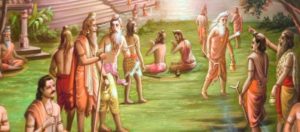When we’re ill or sad. We pray! When we want to score good marks even after studying so much. We pray! All of us pray for various reasons, some to different gods, some to a supreme god. But where did the idea of gods or divine enlightenment originate from? When did we our gods decide to differentiate and have their own religions? Let us travel down the devotional paths to the divine and answer these questions.
The Idea of a Supreme God
Do you believe in the idea of a supreme god or supreme power? Can you feel some energy when you visit a temple or church? The idea of a supreme god looking over us is active in various communities. Idol worship and other forms of preaching are believed to be a comforting practice to relax our mind and soul. In India, the path to Godly fondness took years to establish and expand. Let us analyze the development of eternity in the nation, which is now quite prominent among the booming population.
Road to Devotion in India
In India, the idea of God and a supreme power over all humans has been persistent since ages. The presence of various religions preaching their own Gods is very much evident. Hindus, Muslims, Sikhs, Christians etc., all have put their faith in a deity who looks over them.
Looking back into the past, there have been incidents that have reshaped devotional paths to the divine in India.
- Well before the start of the 7th century, Jain, Buddhist and other faiths present in the Indian sub-continent assumed they are all equal and hold the right to live and stay free.
- Right before the establishment of empires, the masses worshipped diverse gods and goddesses. However, as kingdoms expanded into empires, the ideology of birth and rebirth, together with karma became broadly accepted.
- In the 7th century, the idea of human beings not standing equal, even at birth started to spread. Furthermore, social privileges are confined to higher caste also emerged as one of the prominent beliefs.
- A large number of people didn’t believe this idea and moved towards Buddhism or Jainism. Here the road to salvation was paved through personal effort.
- During this phase, other people preached the idea of supreme god. Under this, salvation can be achieved through dedication to a single God.
- Vishnu, Shiva, and Durga were regarded as supreme deities, with their legends and myths gaining importance among Puranic stories.
- Later, the Puranas introduced the systems of worship among local cults. They also mentioned that all devotees can seek blessings of gods, irrespective of their caste.

Bhakti and Philosophy
Devotion did become strong with the enhancement of human emotions and mind. This is where the relationship between philosophy and bhakti came into the limelight. Below mentioned are the main personalities who helped strengthen devotional paths and the idea of supreme God.
Shankara
In the eighth century, Shankara was born in Kerala and was known to be a very persuasive thinker of India. He was a supporter of Advaita (the principle of the oneness of human soul as well as the Supreme Soul). Shankara counselled people to sacrifice worldly things since it is Maya or illusion. He motivated them to move on the path of knowledge as it was the only path to salvation.
Ramanuja
Ramanuja was born in Tamil Nadu during the eleventh century. He was known as a highly prejudiced philosopher of the Alvars. According to him, the path of salvation was only through powerful dedication to Lord Vishnu. Further, he proposed the theory of Vishishadvaita. After this ideology, a new custom of bhakti was introduced in northern India.
New Religious Arrangements in North India | The Idea of a Supreme God
In the later years, many different movements were launched in North India. This was because people from diverse castes and religions jammed at holy places to gain knowledge from pastors of new religions.
Personalities such as Guru Nanak and Kabir prohibited all mainstream religions. However, people like Tulsidas and Surdas acknowledged existing beliefs and worked to make them available to all. It was noticed that Tulsidas believed God as Rama and collected the Ramcharitramanaswritten in Awadhi. On the other hand, Surdas was a strong follower of Krishna. He expressed his devotion my composing Sursagara, Sahitya Lahari and Surasaravali.
Islam
Islam is seen as a sternly monotheistic religion that believes in offering to a single God. Moreover, the rejection of idol worship and abiding collective devotion to God is part of Islam. As time advanced, Muslim scholars established a holy law termed as Shariat. This was formed when the Sufis rejected the proposal. Their desire was to amalgamate with God in the form of a lover who looks for unity with his cherished.
The Idea of a Supreme God Question For You
Q. What was the reason that many teachers rejected prominent religious beliefs?
Ans. A large number of teachers actively rejected prominent religious beliefs since it created divergence in the society. They preached about creating a division based on religion or caste. In specific, teachings which supported the upper caste people, led to the suffering of lower caste people. On a broader picture, the concept of all human beings not standing equal was growing. This alarmed the various teachers to work in harmony for the abolishment of such beliefs and promote unity.